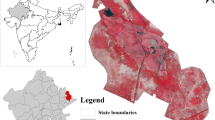Abstract
Geospatial presentation of habitat has become a key issue for planning conservation and management of any ecosystem. Hokersar wetland, one of the best resorts of migratory waterfowl in Kashmir, is under anthropogenic pressure and siltation due to floods. This has resulted in the degradation and change in the habitat quality of varied aquatic flora and fauna. Moreover, the seasonal changes affect the water level and land cover characteristics of the landscape. In the present study temporal mapping of the wetland has been carried out using the data sets for the autumn and spring seasons to assess the land cove/land use dynamics. The temporal change analysis, in the urban sprawl and the wetland, has been carried out to assess the rate of changes in the wetland and its environs. The wetland initially comprised of patch of marshy waterfowl habitat with some open water bodies. It has been fragmented into a large number of land uses because of anthropogenic activities. The increase in the settlement has been observed proportionate to the rate of fragmentation in the wetland. This study has created an information base, which will help to design conservation schemes for long term maintenance of the wetland.
Similar content being viewed by others
References
Anonymous, (1991). Manual for Mapping of Coastal Wetlands/Landforms and Shoreline Changes using Satellite Data, Space Application Center (ISRO), Ahmedabad.
Kapetsky, J.M. (1987). Satellite Remote Sensing to locate and Inventory Small Water Bodies for Fishing Management and Aquaculture Development in Zimbabwe, CIFS/14, CIFA/87/LNF, Food and Agriculture Organisation, United Nations Organisation.
Kaul, V. and Zutshi, D.P. (1967). A Study of Aquatic and Marshland Vegetation of Srinagar. Proceedings of the National Institute of Science, India 1967,33b: 111–127.
Pandit, A.K. (1980). Biotic factors and food chain structure in some typical wetlands of Kashmir. Ph.D thesis, University of Kashmir, Srinagar, India.
Pandit, A.K. and Fotedar, D.N. (1982). Restoring damage wetlands for wildlife, Journal of Environmental Management,14:359–368.
Pandit, A.K. and Qadri, S.S. (1991). Floods threatening Kashmir wetlands, Journal of Environmental Management,31:299–311.
Rashid, Humayun and Joshi, P.K. (2000). Evaluation of Waterfowl Habitat in Hokersar Wetland Reserve, Jammy & Kashmir; A Geospatial Approach. Report, URS, Dehradun.
Author information
Authors and Affiliations
About this article
Cite this article
Joshi, P.K., Rashid, H. & Roy, P.S. Landscape dynamics in Hokersar Wetland, Jammu & Kashmir—An application of geospatial approach. J Indian Soc Remote Sens 30, 1–5 (2002). https://doi.org/10.1007/BF02989971
Received:
Accepted:
Issue Date:
DOI: https://doi.org/10.1007/BF02989971




